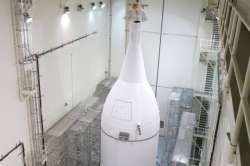NASA's Orion all set for Dec 4 test flight
Washington: Designed to carry astronauts to deep space destinations like Mars, NASA's Orion spacecraft is all set to blast off for its first test flight Dec 4.To be launched atop a Delta IV heavy rocket

Washington: Designed to carry astronauts to deep space destinations like Mars, NASA's Orion spacecraft is all set to blast off for its first test flight Dec 4.
To be launched atop a Delta IV heavy rocket from Cape Canaveral Air Force Station's Launch Complex 37 in Florida, Orion will not carry any people on its test flight.
However, it will help engineers understand what conditions will be like inside the cabin as Orion travels through high radiation and extreme temperatures during this flight, NASA said in a statement.
Orion will travel to an altitude of 5,793.6 kms - 15 times higher than the International Space Station - orbit Earth twice, then splash down in the Pacific Ocean four-and-a-half hours later and be recovered.
The SCIFLI (Scientifically Calibrated In-Flight Imagery) team, based at NASA's Langley Research Center in Hampton, Virginia, is preparing to capture thermal snapshots of the super hot re-entry of Orion into Earth's atmosphere following its first test flight.
"This is going to be a tough one. Orion will come through the atmosphere at 20,000 miles an hour as a tiny dot in the sky. With the capsule initially hundreds of miles away, it is like we are looking for it through a small soda straw," said Tom Horvath, SCIFLI principal investigator.
"It is all about getting the aircraft positioned at the right location at a precise point in time. The action will be in the last minute. Temperatures will go from very low to up to 2,204.4 degrees Celsius," Horvath added.
The team will use a US Navy NP-3D aircraft, also called Orion, to capture the imagery.